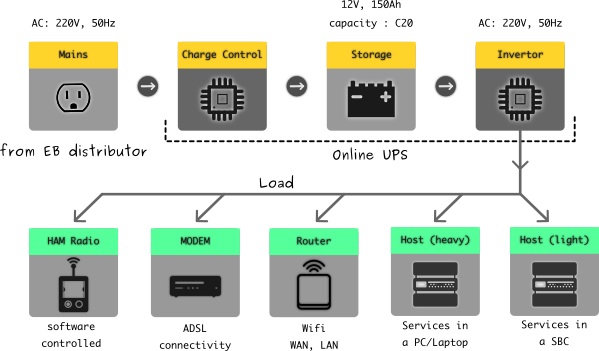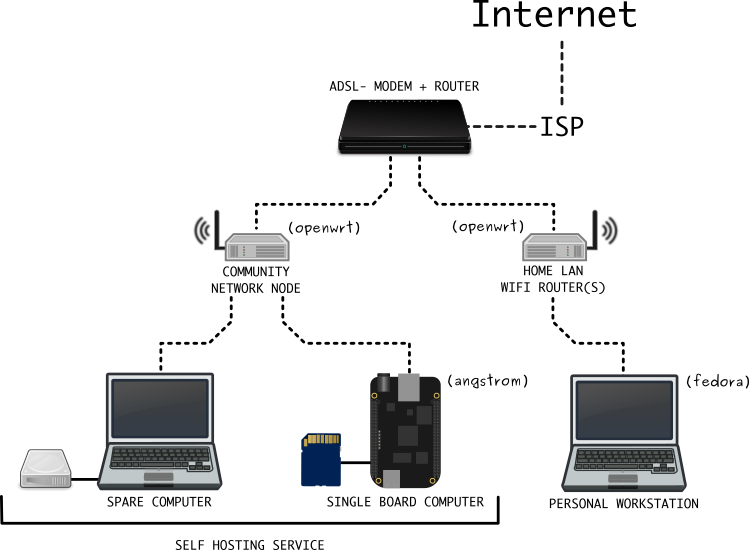DISCLIAMER :
I have shared the information from my subjective experience. I would not like to take responsibility for you have done anything crazy and dumb on your side when attempting to do the stuff i have listed here. Furthermore, i always break things and change stuff, which means, i would constantly keep this post updated, and thus following exactly as here might be a bit hard. On the other hand, i will not restrict you to try this at your home, after all it is in your discretion. Happy Hacking !
TO START:
Based on my previous learnings and my peers recommendations from the community network groups, i have iterated the layout of the required design that would satisfy my need through several iterations. For now i have settled in organizing a hierarchical network setup that help easily organize and manage my local area network which my devices are connected together, that runs required services & functionalities which i aspire to host my self. For this instance this blog/website itself. As covered in the devices post, a lot of stuff has to be considered before even making a hackable device. If the community has a set of open designs for the devices used, then it would be wise and economic to use the locally made device, than importing a "open supportive" (non proprietary/non-tivo) device.
WHAT I HAVE ?
Let me start with what devices i have in hand. Eventhough, i have fascinating ideas for network setup that would only mean a imagination rather than reality that can atleast produce a functional action. Devices are not immaterial and thus consumes power for its programmed operation. The current power infrastructure in my home is being used to power all these devices, which is a Uninterruptable Power Supply system built for home appliances, as a power backup during electric grid power outage. As depicted in the power infrastructure, and from the following table i could approximately get a power budget that would be consumed by the communication infrastructure. Later when the power system is updated with a renewable energy source this data and calculation would be of remarkable use to calculate the necessary power devices to be made or procured to integrate and update the power infrastructure itself.
| Appliance | Purpose | Usage/Power |
|---|---|---|
| Software Controlled Radio |
Amateur Radio | <10%/5W |
| ADSL Modem | Internet | 100%/5W |
| Wifi Router | Local Network | 100%/5W |
| BeagleBone Black |
Hosting | 100%/5W |
| PC/Laptop | Hosting | 100%/60W |
| PC/Laptop | Personal Use | <50%/60W |
One must not forget about the connecting medium that enables linking between different types of devices, with proper interfaces. Now, common sense, says that the current technology available in wireless medium using proper antennas and radio, (economic & open) are not equivalent in performance when comapared with the wired medium. Thus in general, i have tried to reduce the usage of wireless mediums when trying to connect devices in the hierarchical structure. Both cost & performance are better than the wireless medium - unless wireless interface is inbuilt in the devices itself. Ethernet cables with RJ45 ports, coaxial cables with suitable connectors, will be required to properly connect antennas with the radio modules in wireless devices. Since visions of community networks have planned with wireless mediums, to enable less clutter, and more connectivity with the neighbouring peers, atleast one device would be required to represent it as the community node.

With the power supply in place which is compatible with the calculated power budget, can now be connected together to form a local area network. The network architecture - i.e, the topology can be decided by the organizer of the network. As said, i would like to implement a hierarchical topology which is very much the pattern of the existing internet. This structure would enable me to establish a easily scalable network within the home, and at the same time serve as a transitional base to make my device and services to be a part of community network.
WHAT IS MY NETWORK STRUCTURE ?

Block diagrams are much better than textual explanation aint't ? So, the above diagram depicts the current status of the network which i have setted up with very minor modifications for clarity. My goal is to have a community network node, along with access to Internet. I am sincerely not OK with the most of current internet and web architecture. It needs an update and many communities around the globe are doing whatever they can to bring the change. It sounds radical for those : -- who got addicted with the centralized social networks; fine about subscribing to a monitored & paid private service just to communicate... and all. Thus as a unavoidable balance, i am using such a mix of communication :
- Community Network Node (Internet from commons)
- Software Defined Radio (Modern Amateur Radio)
- ISP provided Internet Access (paid & monitored)
As said the current network structure is hierarchical mostly. And i really cannot find any reason to go for any other kind of structure. However, when the hardware available with better beam steering and higher bandwidth, it would be useful to have a hybrid mesh topology to have better spatial and spectral coverage. With the above network setup, theoretically it is possible to share and propagate a content through 3 infrastructures. I could have a personal station where it is easy to propagate my digitized voice as :
- Podcast through my self hosted website/blog to my locality & community
- Propagte the voice through proper radio license (amateur or community radio)
- Podcast through my web hosted website/blog; centralized social network
MY NETWORK COMPONENTS :
To construct the above network, one has to first have the required resources such as cables, connectors, modem, router(s), computers, radio, antenna, operating system distributions, software services, etc.. However to get the above structure, the hardware devices as envisoned has to be connected together with proper interfaces. Typically connectors and cables will be come along with the hardware purcase. My hardware list is provided below:
| Device | Make. | Cost/Unit |
|---|---|---|
| ADSL MODEM + Router |
BSNL | ~1500. ₨ |
| Wifi Router | TPLink MR3020 |
~1200. ₨ |
| Radio (optional) | HAM Community |
~8000. ₨ |
| BeagleBoneBlack | SBC - TI | ~3000. ₨ |
My hardware modules actually goes back few years back and thus there might be significant change in hardware price. I have not shown laptop computers in the list, as anybody can have one of their own liking. So far, in the list only the cost of a HAM radio - a software controlled one, is the only costlier unit. Since the HAM radio is made by the amateur radio community, and have made only for a workshop on SDR the cost is seems higher than average. If one could compare its price tag with the mass manufactured one, then it would become clear how cost effective it is with the flexibility and inherent advantages it comes with. The cost is around ~ 8000. ₨, for atmost 10 people in the workshop. Thus with more demand, the price margin can be significantly reduced. I've got the board, and by co-operating with others in the community have completed soldering the board in 2 day shift. It is really a insiring experience in peer-producing a hardware that really works which can ultimately even save people during disaster.
TPLink MR3020, is a Wifi (2.4GHz - IEEE 802.11 b/g/n) compatible hardware, which is flashable with any GNU/Linux based embedded distros like Protean OS ; OpenWrt ; LEDE . I have purchased them by 2014, and tried mesh networking with other friends in our dorm. This is also the time when we have purchased the famous RTLSDR, to listen to wide range of radio channels. The meshing attempt have actually failed because of our lack in actual knowledge of mesh protocols, and other shitty human stuff that get in midst of such worthy triumph.
In the mean time, i have learnt about such embedded GNU/Linux distros apart from my existing knowledge in it and get exposed to serious policy decisions that would affect the very transparency and scientific liberty embedded in the communication systems. However, MR3020 is one of those portable, USB powered, economic & OpenWrt flashable router one could easily play and experiment with. It is also the first commercial equipment which i have hacked it with serial I/O, and also learnt about Radio chipsets used in wifi routers. Cooooool experience so far.. )
During my research tenure, i have purchased some of the SBC's ( Single Board Computer ) to hack and experiement with them. With one BBB ( Bealge Bone Black ) board left with me, i am currently using it with angstrom distribution, to host some of my light weight self hosted services. Certainly happy in using a fully free hardware
WHY SO & WHAT'S THE PLAN ?
I believe, that reaching people locally is equivalently & as important as reaching globally. Places near me is more relevant & related than far from me. How the content is getting diffused through the mediums is useful in measuring and interpreting how many people it gets interacted and reshared. Thus while integrating the hardware to form a network topology, the following factors shall be considered :
| parameter | maps to | founts from |
|---|---|---|
| spatial coverage | network spread | geography |
| network reach | social density | information |
The diffusion of information, and the resulting social interaction gained from the coverage provided by the hardware infrastructure, is essential for any information flow. This further decides the emergent formation of connections and disconnections between the participants in the network. This makes the resulting social network so dynamic. The information flow depends upon the fundamental hardware layout, and thus it decides the crucial design of the information flow itself. The goal of information sharing is to reach as much partipants as possible, no matter how bad the environmental situation is. Thus it is more necessary, during the times of interference caused by punitive subjugations, natural disasters / calamities, etc... Communication has to exist devoid of social, environmental conditions. Thus such a real necessity must try to have several alternative design strategies, that can parallely or together function to enable flow of information. In other words, resilience through deisgn. This is a function of how reliable the hardware and the integrated network is.
I do not know whether my network setup is resilient for any situation, but the present status suits my needs.






